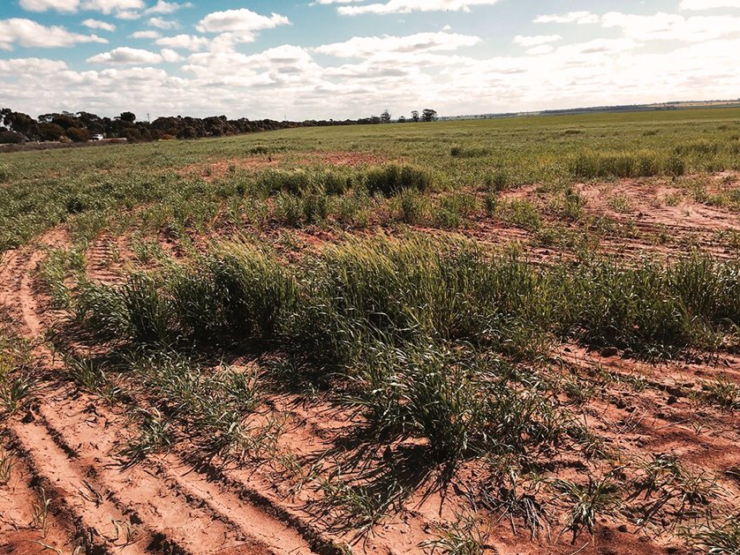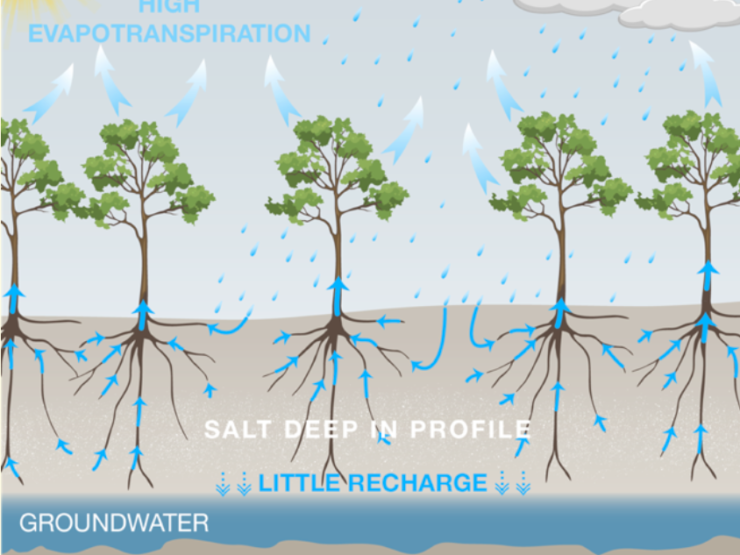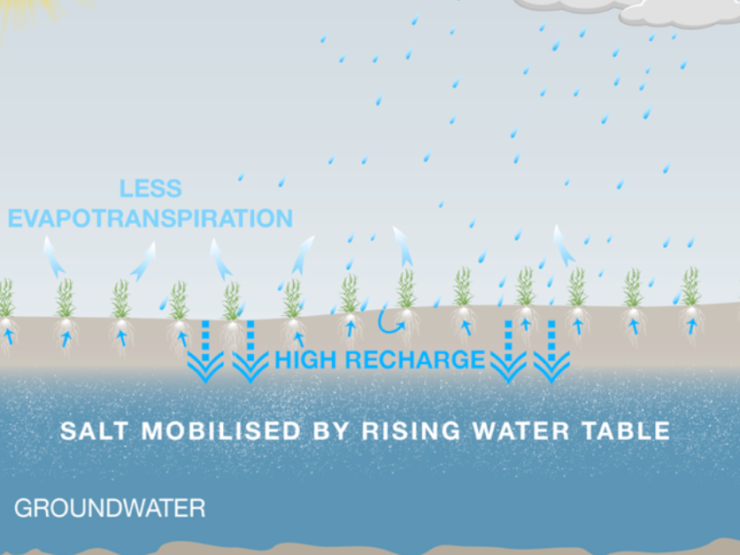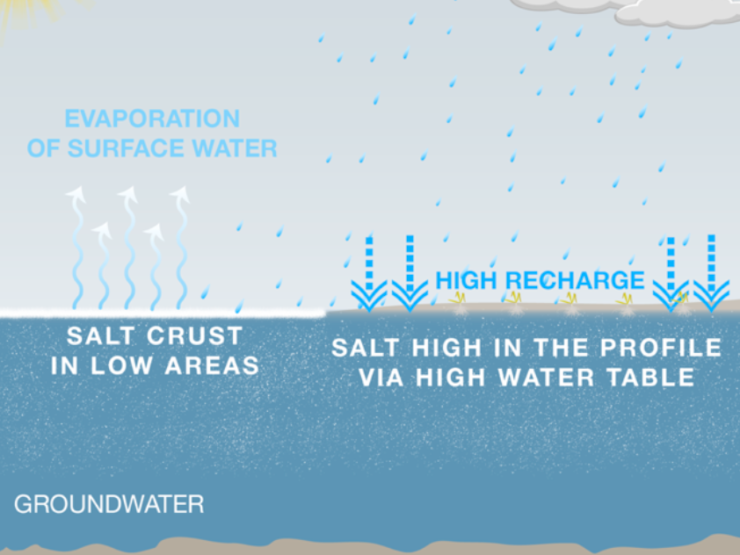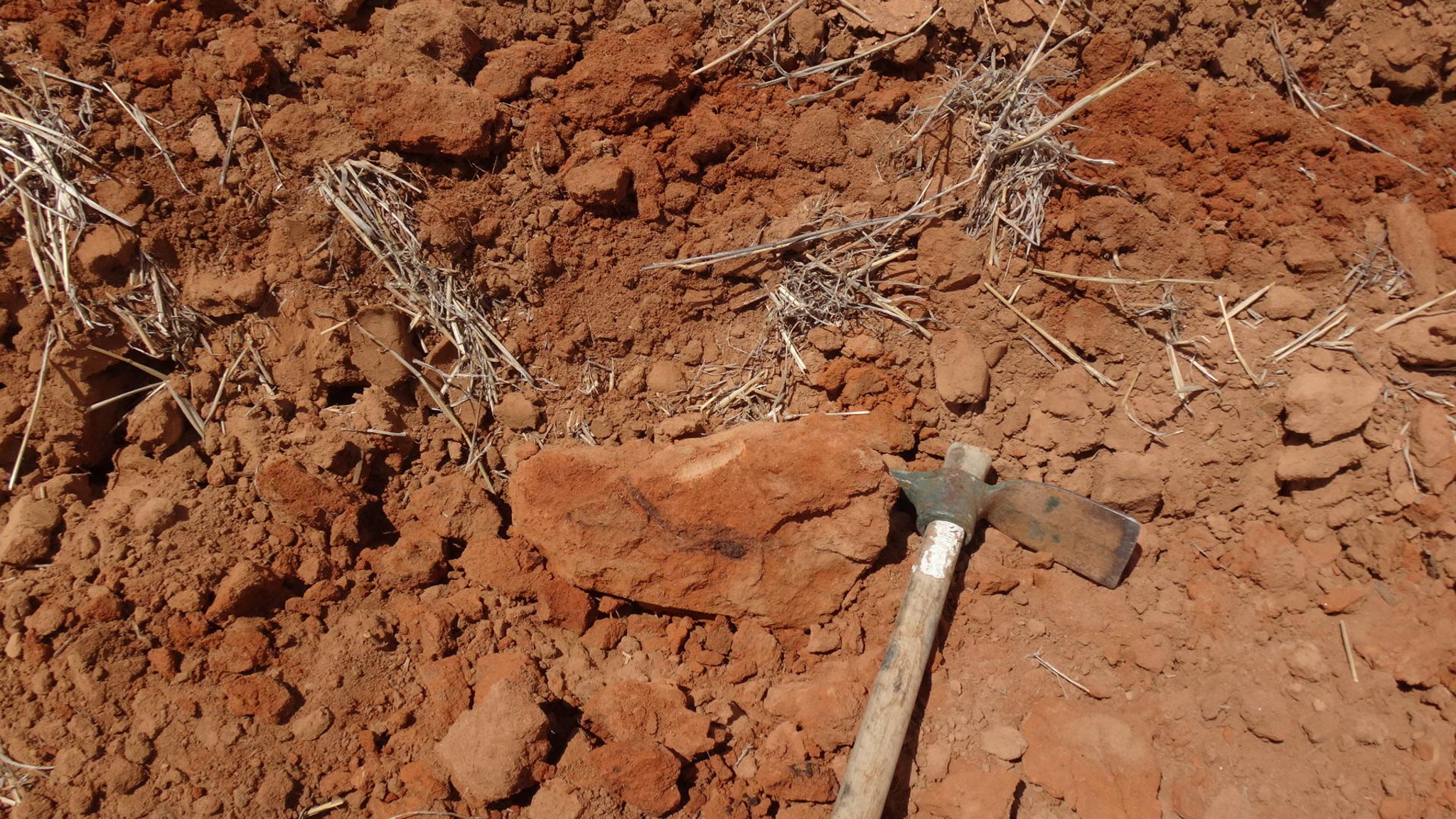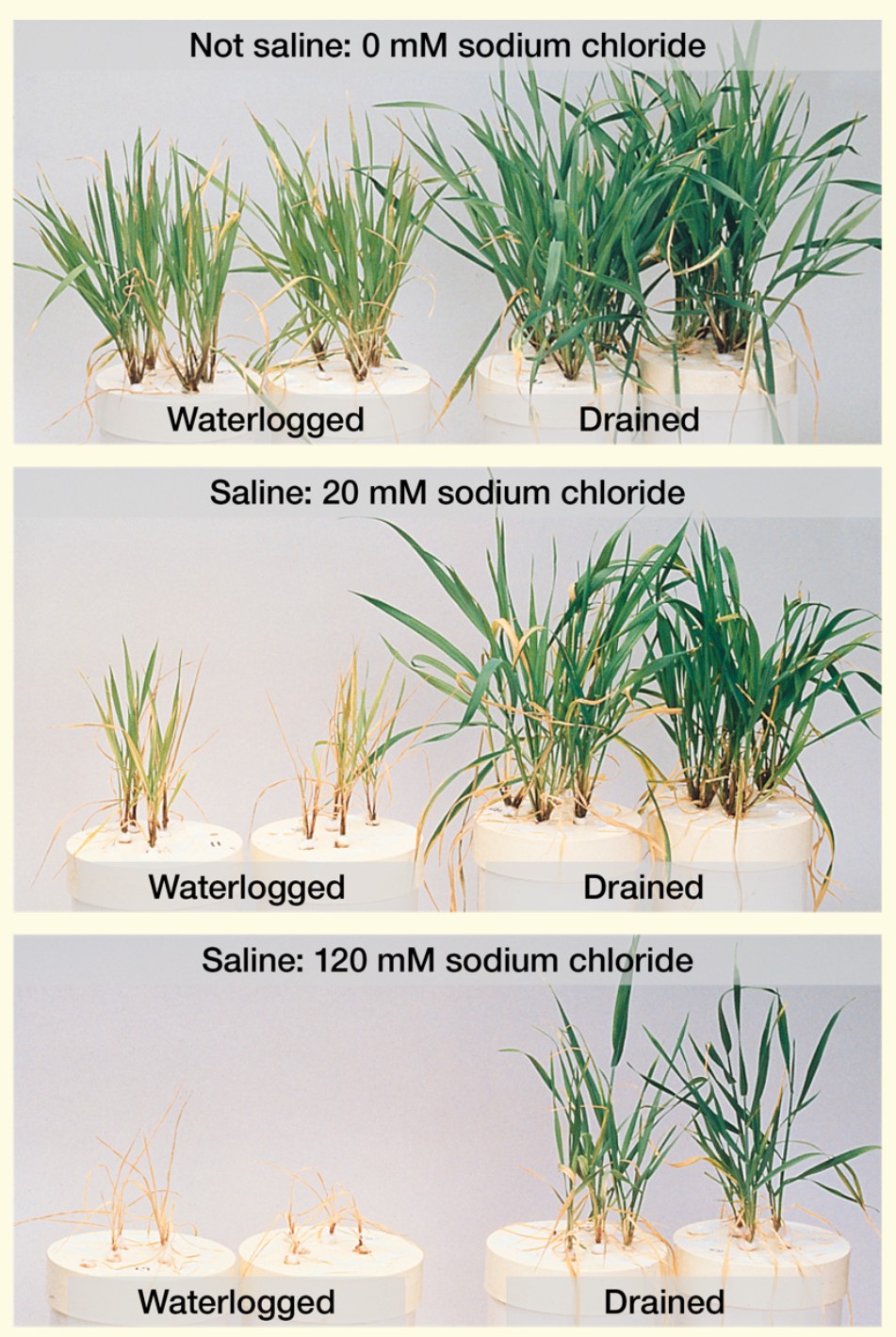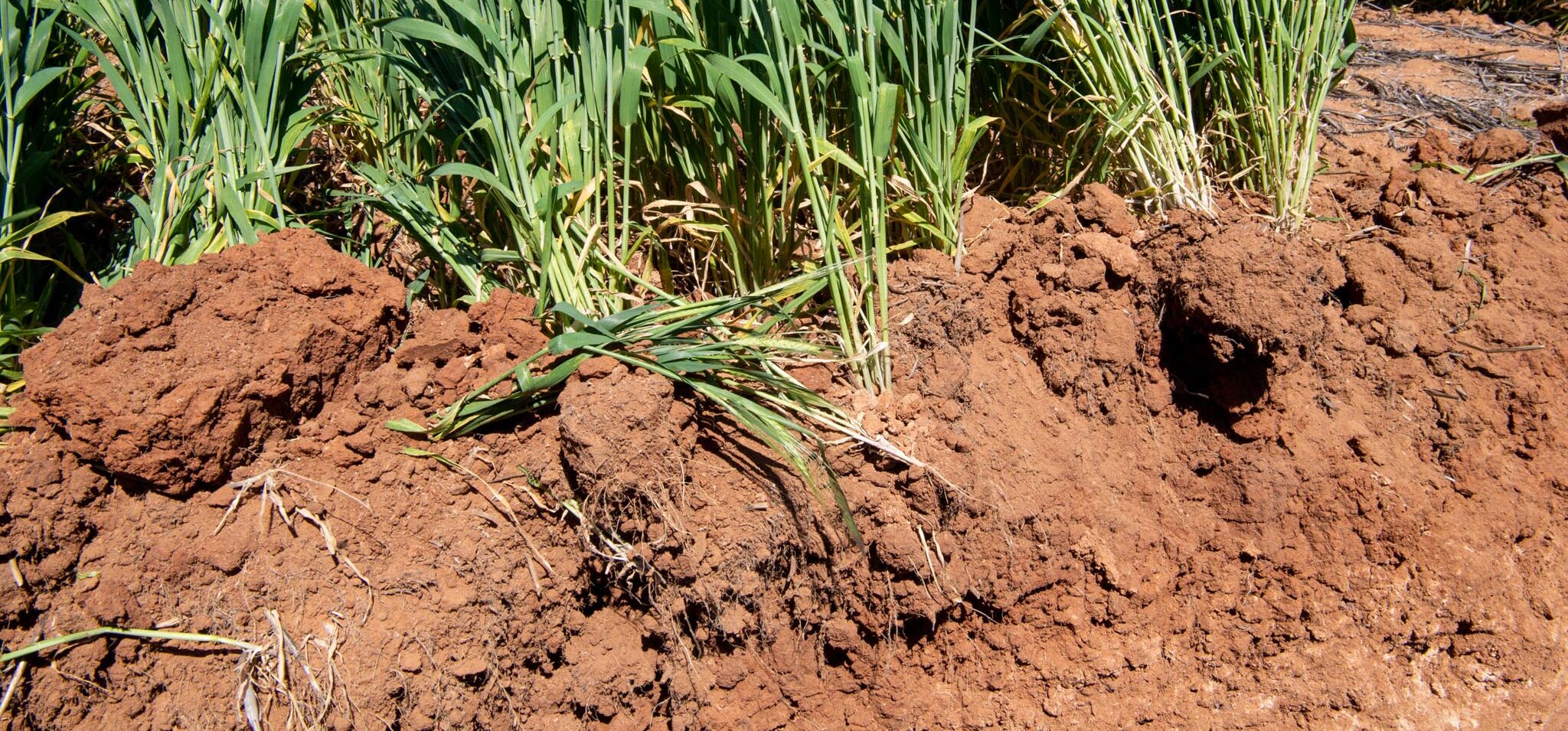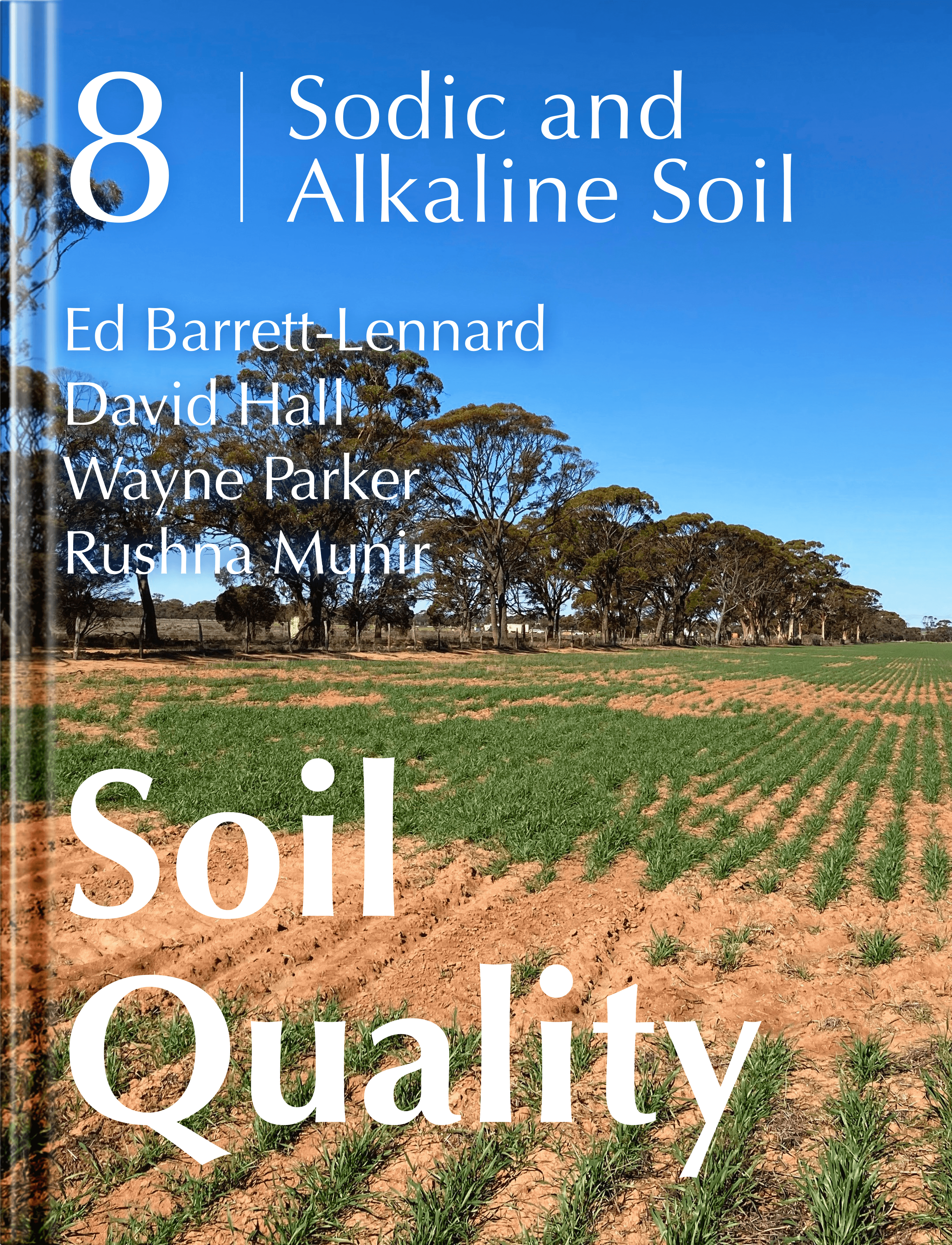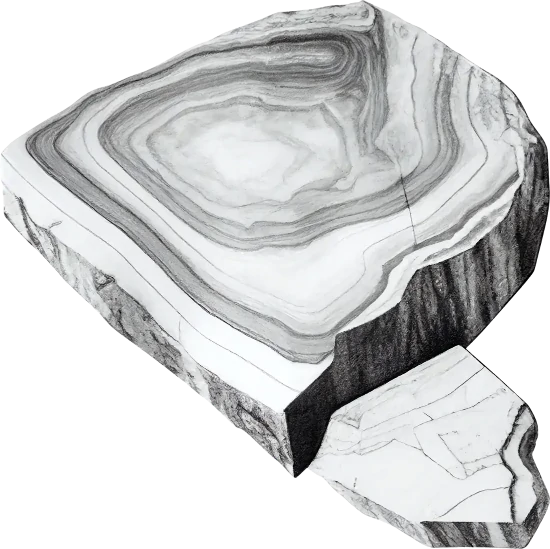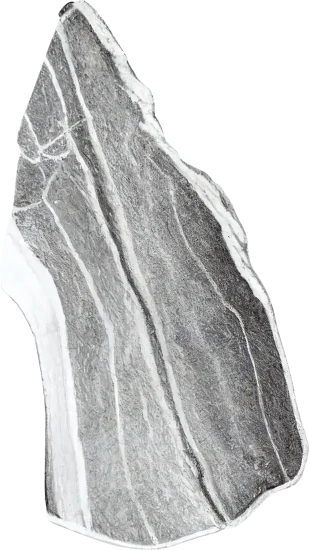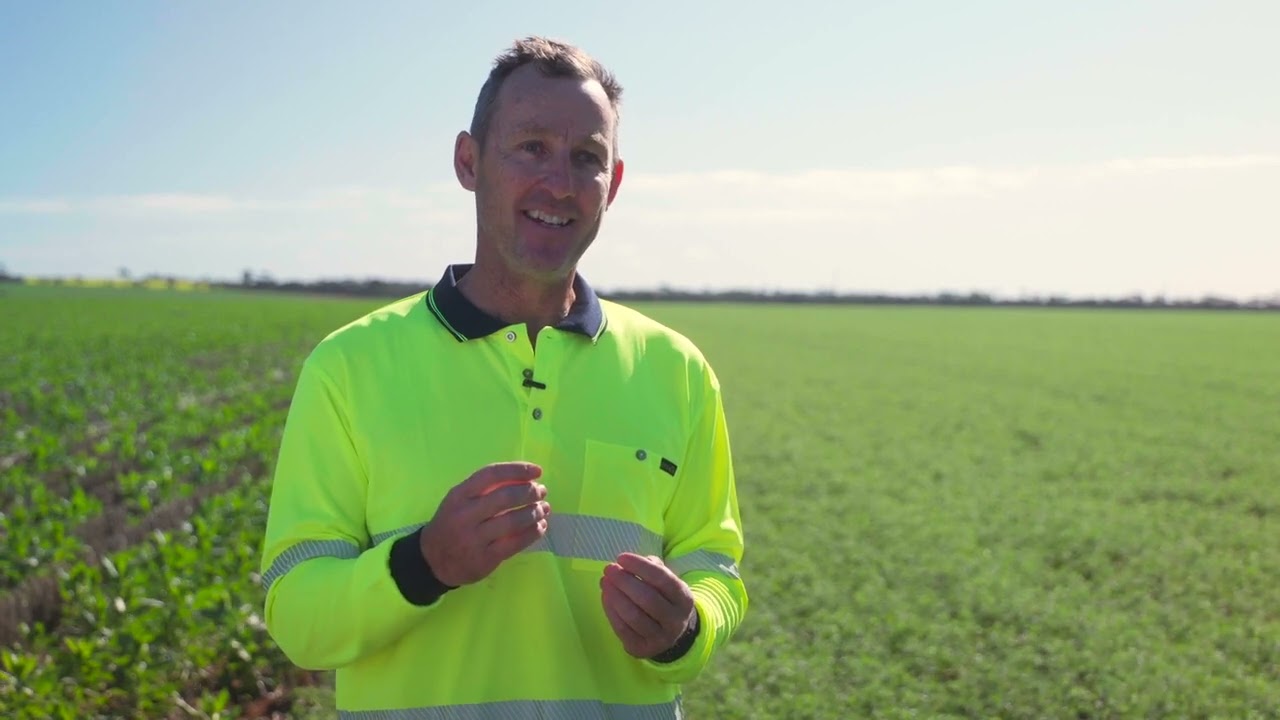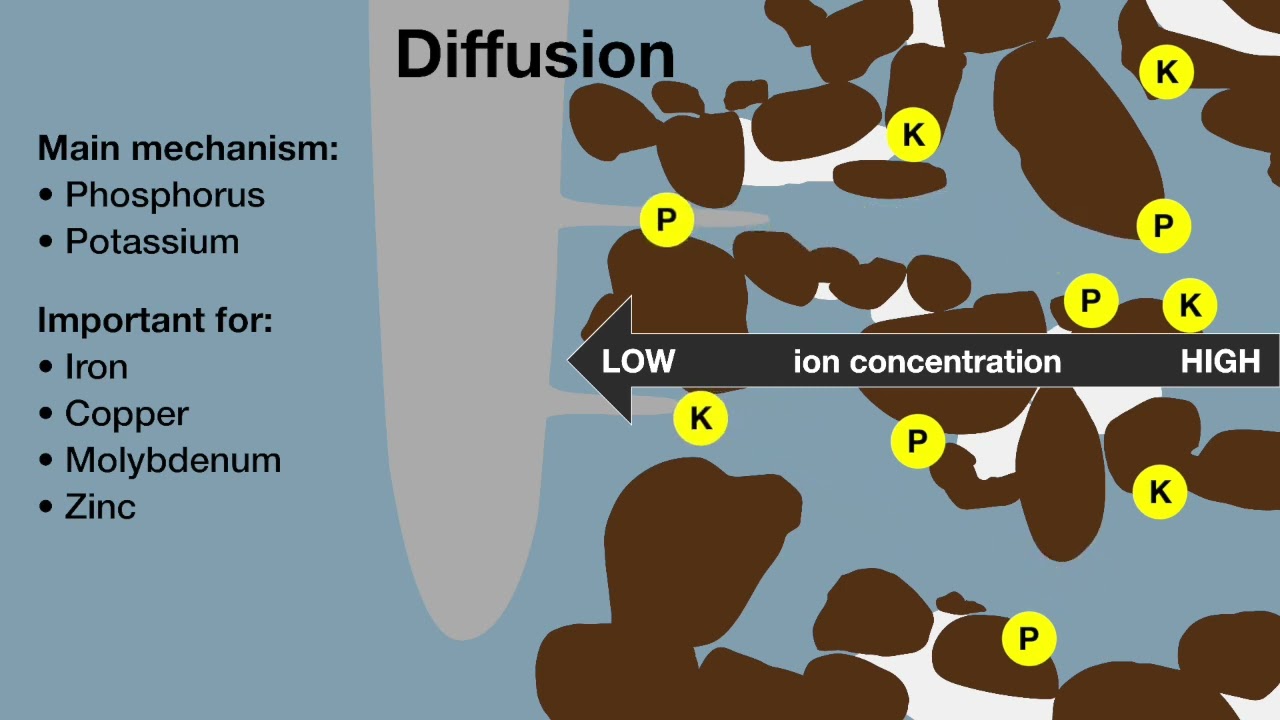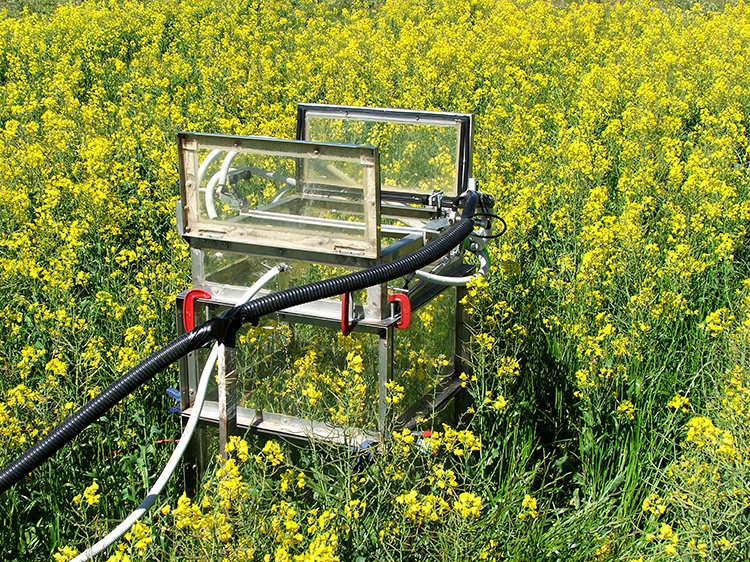What is soil salinity?
Salt occurs naturally in all soils.
Salts in soil are derived from a variety of sources including
- weathering of salt-rich parent material,
- wind-borne salt from oceans and salt lakes, and
- through the application of irrigation water.
The salts achieving highest concentrations in soils are common or sea salt (sodium chloride, NaCl), lime (calcium carbonate, CaCO3) and gypsum (calcium sulphate, CaSO4.2H2O). The most common salt associated with salinity is NaCl.
Two main forms of salinity are recognised in Australia:
Primary (naturally occurring) salinity, and
Secondary salinity associated with human activities.
Primary salinity occurs in arid climates throughout the world. These areas include salt marshes, salt lakes and salt flats, all of which are considered ecologically significant. Some saline areas have naturally saline subsoils without saline topsoil.
Secondary salinity includes salinity from irrigation and from rising groundwater following extensive clearing of deep-rooted native vegetation in dryland agriculture.
Primary salinity can affect plant growth to a depth of 90 centimetres or more, but a concentration of salts in the top layers of the soil horizon can also occur from the upward movement of water. Saline watertables may be perched and localised, whilst others are deep and widespread. The depth and concentration of saline layers can change over time as salts are leached or rise with capillary action, and as groundwater levels change, in both primary and secondary salinity.
Causes of soil salinity
Many geological formations beneath soils used for agriculture have marine origins and often contain high levels of salts (particularly sodium chloride).
In many regions of Australia, potential evaporation is higher than the amount of rainfall. Consequently, most of the water that infiltrates into the soil is extracted by plants to be transpired, or it evaporates from the soil surface. This tends to leach salt contained in the rain down the profile and helps reduce salinity in the surface soil while increasing the salinity of subsoils. However, there are many dry inland regions of Australia where the soil is saline to the surface and do not receive sufficient rainfall to leach salt out of the soil profile. These tend to be areas in the lowest parts of the landscape where runoff water accumulates during rare rainfall events, and the water evaporates to leave the salts behind. This has occurred over millions of years.
Fluctuations in water table depth are influenced by the amount of recharge (water entry) and discharge (water loss). Groundwater levels rise when the input of water to the groundwater system (recharge) exceeds the amount of groundwater leaving the system (discharge).
Permeable soil profiles aid rapid rainfall infiltration, allowing water to soak in quickly and enter the groundwater. The influence of changes in the amount of groundwater, as well as contributing factors such as vegetative cover, soil management, disruption of natural drainage lines, irrigation and topography can contribute to the formation of potential recharge areas. Discharge areas can be associated with barriers to the movement of groundwater (for example, clay layers and non-permeable rock) and groundwater pressure, forcing water to the surface. However, they may also be associated with local groundwater systems, where shallow groundwater will flow and discharge into areas that can then be affected by salinity. Water loss from a groundwater system can occur through evaporation, pumping, seepage, springs and baseflow to rivers and lakes.
Where groundwater levels are about one metre from the surface, the capillary rise of saline groundwater causes salts to accumulate at the soil surface and in the root zone. This salt may emerge as a ‘saline seep’ or where a flat, bare area of naturally saline clay subsoil is exposed by erosion. Evaporation at the surface leaves behind concentrated salt deposits known as ‘saline scalds’. Clay soils with a high bulk density in the subsoil and slow drainage tend to accumulate salt.
Leaching (downward movement) of salts down the soil profile largely removes salt accumulated in the root zone. The lateral movement (parallel to the slope) of water can result in salt accumulation in downslope soils. Land management changes such as clearing and grazing can lower water use and increase the movement of salts towards the soil surface, as well as lower parts of the landscape – increasing the risk of salinity.
Subsurface drainage in leaching soils helps remove localised salt beyond the rooting zone of plants, draining into groundwater and/or waterways. However, in soils that are not freely drained, the lateral movement of water may cause saline water to seep to the surface elsewhere. In a confined system, water cannot drain away, resulting in rising groundwater levels, bringing salt to the surface. In a hill and valley landscape, a rising water table causes the area of naturally saline soils to gradually extend upslope, bringing salt towards the soil surface.
Replacement of deep-rooted native vegetation (often trees, including summer-active species) with shallower-rooted annual crops and pastures results in less evapotranspiration over the year. Consequently, there is greater percolation of water below the root zone. As a greater proportion of the rainfall moves down through the soil as deep drainage, the groundwater begins to rise. The response time of a regional groundwater system to this increased deep drainage varies from a few years to decades. Sometimes, runoff is also increased. Droughts greatly reduce deep drainage losses from agricultural systems, causing the expansion of salt-affected land to be slowed.
Water storage and delivery channels associated with irrigation often leak and cause local water tables to rise and surface salinity to develop. However, most of the salinisation under irrigation comes from inefficient irrigation practices whereby water is applied in excess to crop demand over a number of years. In much the same way that clearing deep-rooted vegetation changes the amount of rainfall percolating to groundwater in dryland agriculture, too much water percolating below the root zone of irrigated crops causes the groundwater to rise gradually.
Water quality is important when applying irrigation water to a crop. It is vital to know its salt content and the proportion of the salt that is sodium chloride. Sodium chloride is undesirable firstly because sodium and chloride can be toxic above certain concentrations and secondly because sodium can make the soil more sodic.
The following equation can be used to estimate the amount of salt imported via irrigation water:
Salt input (t/ha) = Megalitres irrigation water (per ha) x EC (dS/m) x 0.64
Causes of salinity include barriers to the movement of water which can include roads, railways and land reformation.
Dryland salinity compared with transient salinity
Dryland salinity is the salinity associated with the development of a shallow water table due to the clearing of the original native vegetation and its replacement by annual crops and pastures. It frequently results in the loss of the land from conventional forms of agriculture, and is the form of salinity with which most Australian farmers are familiar. Land affected by dryland salinity is highly, severely or extremely saline and may have salt crusts at the soil surface. Often, it is only suited to the growth of highly salt-tolerant plants like samphires (Tecticornia spp), bluebushes (Maireana spp.) and saltbushes (Atriplex spp).
Transient salinity is the salinity associated with dispersive (sodic and alkaline) clay soil. Land affected by transient salinity is generally vegetated and commonly used for the growth of crops or pastures. It is slightly or moderately saline and is not associated with the presence of salt crusts at the soil surface.
Development of dryland salinity
Airborne salts are contained in pollution, smoke and ocean spray. These salts are dissolved in atmospheric moisture and are deposited on the land during rainfall. After the water evaporates, the salt can build up in the soil over time. In freely-draining soil, the salt is leached deep into the soil profile by rainwater. Where soil has not been cleared for agriculture, deep-rooted native vegetation uses most of the water that falls as rain as it percolates through the profile, with little ‘recharge’ of groundwater, meaning that the water table remains at a more-or-less constant level deep in the soil profile. Where native vegetation has been cleared and shallow-rooted agricultural plant species are grown, much less of the water that falls as rain is used. Unused water leaches through the soil profile into the groundwater and the water table rises. As the water table rises, salt that was stored deep in the soil profile is brought up into the rooting zone of plants. In low-lying areas, the water table rises to the surface and water evaporates, leaving salt crusts.
Development and expression of transient salinity
Similarly to soil affected by dryland salinity, salt originating in the oceans accumulates in soil. Unlike dryland salinity, transient salinity is associated with dispersed clay in the soil that prevents salt from leaching through the profile and accumulating in the root zone. This salt may have little effect on crop growth in wet years when rainfall is sufficient to dilute salt concentration and allow the crop greater access to water but contributes to yield decline in dry years. Farmers are often unaware that their sodic and alkaline land is also affected by salinity.
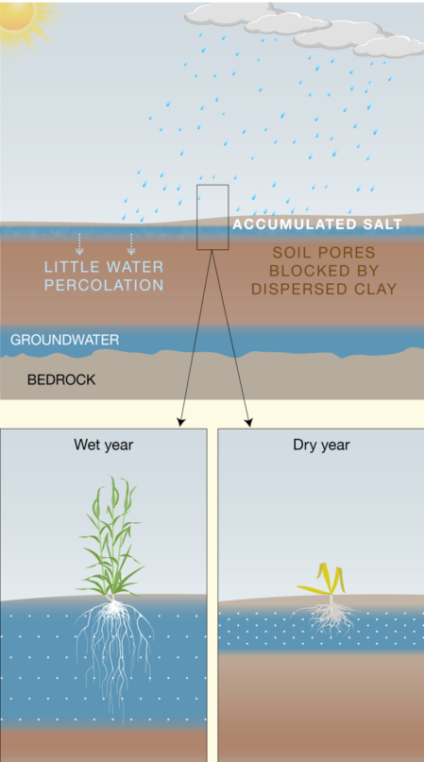
Impact of soil salinity
Loss of productive land
Most agricultural crops and native plants are adversely affected by salinity. As the salt concentration increases, the energy of water in the soil decreases such that it is more and more difficult for plants to extract that water, even though the soil seems relatively moist. The plants are unable to take up the water and nutrients they require. Hence, soils with too much soluble salt in the root zone effectively create a ‘chemical induced drought’ and the plants may wilt and die. In most cases, the salt or ‘osmotic’ impact is felt before symptoms of toxicity due to sodium and chloride appear. Seedlings are more susceptible to salinity stress.
Nutrient supply
Sodium (Na) and chloride (Cl) ions can be toxic. Some plants (e.g. barley) are able to restrict the entry of these ions, but others (e.g. chickpea) cannot. Symptoms of leaf burn or necrosis and reduced growth may indicate toxicity. Localised salinity damage can temporarily occur through the application of soluble fertilisers too close to salt-sensitive seedlings under dry conditions (i.e. fertiliser burn).
The osmotic effect of salinity may be accompanied by toxicities such as excessive boron and chloride. Where boron toxicity is a concern, gypsum can be used to accelerate the leaching of borate anions through its effect on soil structure and because it can convert readily soluble sodium metaborate to less soluble calcium metaborate.
Soil structure decline
Salinity is often associated with areas of structural decline and increased risk of erosion. Sodic soils are commonly found in association with sodium chloride (NaCl). The effects of soil sodicity may be worse in the absence of salinity.
Susceptibility to erosion
Salinity reduces ground cover, often leaving soil bare and can contribute to an increased risk of wind and water erosion.
Reduced water supply
The mobilisation of salt through changes in land use, can lead to a reduction in the quality of both surface water and groundwater supplies affecting agricultural production and environmental quality.
Loss of biodiversity
Increasing salinity causes death of native vegetation, declines in wetland health, shifts in the ecological balance of species or loss of ecosystem function, and a loss of biological diversity (fauna, flora, microorganisms). These losses can result in greater degradation of the soil resource and less resilience to imposed stress or changing climate.
Diagnosing soil salinity
A common method for assessing soil and water salinity measures the electrical conductivity (EC) of the soil extract or water. Dissolved salts increase electrical conductivity of water so a high EC value indicates a high salinity level.
Measurements of salinity are usually expressed as values of electrical conductivity such as deciSiemens per metre (dS/m) or microSiemens per centimetre (μS/cm or ‘EC’ units). Actual salt concentrations such as milligrams per litre (mg/L) and parts per million (ppm) are also used.
For water: 1 dS/m = 1 mS/cm = 1000 μS/cm = 640 ppm = 640 mg/L total soluble salts
Salinity measurements are often reported with subscript abbreviations to indicate the origin of the sample tested and the method of measurement.
- ECw is the salinity of water.
- EC1:5 is the salinity of a 1:5 soil:water extract and must be converted by an appropriate factor to estimate the amount of salt in a saturation extract of the soil (ECe).
As a guide, soils are generally considered saline if their ECe is greater than 2 – 4 dS/m.
Categories of salinity in soil and the associated ranges of electrical conductivity measured as ECe and EC1:5
| Salinity category | ECe (dS/m) | Sand EC1:5 (dS/m) | Loam EC1:5 (dS/m) | Clay EC1:5 (dS/m) |
|---|---|---|---|---|
| Non-saline | 0 - 2 | 0 - 0.14 | 0 - 0.18 | 0 - 0.25 |
| Slightly saline | 2 - 4 | 0.15 - 0.28 | 0.19 - 0.36 | 0.26 - 0.50 |
| Moderately saline | 4 - 8 | 0.28 - 0.57 | 0.37 - 0.72 | 0.51 - 1.00 |
| Highly saline | 8 - 16 | 0.58 - 1.14 | 0.73 - 1.45 | 1.01 - 2.00 |
| Severely saline | 16 - 32 | 1.15 - 2.28 | 1.46 - 2.90 | 2.01 - 4.00 |
| Extremely saline | >32 | >2.29 | >2.91 | >4.01 |
From Soil Quality: 8 Sodic and Alkaline Soil (Barrett-Lennard et al. 2022).
Barrett-Lennard EG, Bennett SJ, Colmer TD 2008. Standardising terminology for describing the level of salinity in soils. 2nd International Salinity Forum, Adelaide, 31 Mar – 3 Apr.
The saturation extract (ECe) gives a more realistic measurement of the actual salt levels that a plant will encounter, and most data in the salinity literature are expressed in ECe values.
Use the following table to convert EC1:5 to ECe based on soil texture.
For example, an EC1:5 of 0.3 dS/m is equivalent to an ECe of 6.8 dS/m for a sand, whilst an EC1:5 of 0.3 dS/m for a heavy clay is equivalent to an ECe of only 1.7 dS/m
Clay contents, saturated paste water contents and conversion factors to estimate ECe from EC1:5 for soil of different texture classes
| Texture class | Clay % | Saturated paste water content (g/100 g soil) | Range of conversion factor | Mid-range conversion factor |
|---|---|---|---|---|
| Sand, loamy sand, clayey sand | <10 | <20 | >17.6 | 22.7 |
| Sandy loam, fine sandy loam, light sandy loam | 10 - 20 | 20 - 41 | 17.6 - 9.9 | 13.8 |
| Loam, fine sandy loam, silt loam, sandy clay loam | 20 - 30 | 41 - 46 | 9.9 - 9.0 | 9.5 |
| Clay loam, silty clay loam, fine sandy clay loam, sandy clay, silty clay, light clay, light medium clay | 30 - 45 | 46 - 53 | 9.0 - 8.2 | 8.6 |
| Medium clay | 45 - 55 | 53 - 72 | 8.2 - 6.7 | 7.5 |
| Heavy clay | >55 | >72 | <6.7 | 5.8 |
From Soil Quality: 8 Sodic and Alkaline Soil (Barrett-Lennard et al. 2022).
Slavich PG and Pettersen GH 1993. Estimating the electrical conductivity of saturated paste extracts from 1:5 soil:water suspensions and texture. Australian Journal of Soil Research. 31: 73-81.
Indicators of soil salinity
-
Shallow watertable evident in pits
-
White crust or crystals on dry soil surfaces
-
Unusually friable or ‘puffy’ soil structure in low-lying areas when dry
-
Damp patches in otherwise dry soil
-
Unusually clear water in puddles and drains
-
Patches of reduced growth or yield, margin and tip burning of leaves, followed by yellowing and bronzing
-
Subsoil appears wet after harvest, even when the finish was dry
-
Increased numbers of salt tolerant weeds
-
Death of clovers and some trees
-
Bare scalded areas appear and progressively get bigger
-
The presence of bicarbonate salts associated with very high pH values (> 9) may be associated with ‘black alkali’ (greasy-looking black patches) linked to the dispersion of organic matter – also with white “magnesia patches”
Managing soil salinity
Primary salinity
Use crops and pastures (e.g. cotton, barley, couch grass) that are less prone to the adverse effects of salinity than others (e.g. beans, apples, clovers).
Where saline areas have been identified, fence them off to control stock access. Often improvements in pasture cover can be achieved just through the exclusion of grazing animals. Establish salt land pasture species. Excess water with the potential to aggravate salinity problems can be intercepted and re-directed via ground works such as broad surface drains. Subsoil drainage systems can be installed to capture deep drainage water and evaporation basins constructed to store it. Such works generally require formal authorisation from government agencies.
Secondary salinity
A whole-farm approach using a number of strategies is the easiest and least costly way of managing and preventing secondary salinity. Some useful strategies are listed.
Once water levels are within two metres of the surface, the capillary rise of saline groundwater causes salts to accumulate at the soil surface and in the root zone.
Use rainwater more efficiently to minimise deep drainage losses. This could be done by growing higher biomass crops, opportunity cropping, permanently fencing off pasture areas, stock exclusion and avoiding long fallows. Replacing long fallow systems with opportunity cropping or cover crops in Queensland should be considered as a means of increasing water use and reducing salinity problems, as well as protecting soil from erosion.
Intercept excess water and re-direct via ground works such as broad surface drains and reverse interceptor drains. Install surface, subsurface drainage systems and evaporation basins to capture and store deep drainage water. Evaporation basins should be sealed with impermeable clay or a synthetic liner to minimise leakage.
Protect and manage remnant vegetation. Plant perennial pastures and trees/shrubs in recharge areas. Establish pastures on poor producing land or if a mixed farming system, consider alternate components of rotations such as lucerne.
Identify and remove subsoil constraints so roots are able to access water deep in the profile, increasing water use. Introduce deep rooted perennials (i.e. trees, shrubs, lucerne) or pastures capable of growing throughout the year. Improve drainage where temporary ponding occurs after rainfall. The adoption of zero tillage combined with stubble retention has shown increased leaching of chloride salts and movement of the salt ‘bulge’ deeper in the profile.
Water has to be applied to flush out the salts that would otherwise accumulate to the point where crop growth is retarded. This is referred to as the ‘leaching fraction’ and varies for a range of water qualities and crop tolerances. Drainage systems with appropriate drainage capacity should be installed.
Introduce appropriate irrigation scheduling and monitoring, and reduce water loss through evaporation from open water ducts and leakage from unlined channels. Assess the quality of irrigation water. In general, water is considered a low salinity risk if EC is below 0.75 dS/m.
Living with salinity
Salinisation greatly reduces options for farming and landscape management. Although it is important not to leave land bare, avoid cropping saline areas. Saltbush has an extensive rooting system (up to 8 m lateral growth and 3.5 m deep) and can thrive under saline conditions. Species such as sea barley grass and samphire have a high to extreme tolerance of salinity and can provide groundcover under very hostile conditions. There is also a grass, Distyclus spicata, that has been tried in various saline soils
Other ways to live with salinity include the use of evaporation basins to contain saline water until it evaporates, desalinising water (energy intensive and costly) and the adoption of alternative land uses able to utilise saline water (e.g. aquaculture).
Tips for the management and monitoring of soil salinity
- Monitor the salinity status of the root zone.
- Manage subsoil constraints so that deep and vigorous root growth is encouraged.
- Monitor the depth and quality of groundwater using piezometers.
- Monitor the quality of irrigation water using an EC meter.
- When excess salt has to be leached from the root zone, aim to use the minimum possible amount of water (the leaching requirement).
- Install surface or subsurface drain systems where appropriate.
- Maximise the use of rainwater, which usually has much less dissolved salt than irrigation water.
- Where irrigation water is stored in dams, do everything possible to minimise evaporation losses. Evaporation leads to an increase in the concentration of dissolved salts in the water that remains in the storage.
- Minimise seepage losses from storage dams and evaporation basins, which may cause water tables to rise.
- Use crop varieties that maximise water use.
- Grow healthy crops and pastures that will use more soil water. This includes controlling crop/pasture diseases, pests and weeds.
- Introduce conservation farming techniques such as no-till, controlled traffic, and crop/pasture rotations, which will improve soil health and increase organic matter. Maintain soil fertility, pH and structure to encourage growth of high yielding crops.
- Avoid long fallows and bare ground.
- Mulch exposed ground where possible to help retain soil moisture.
- Keep all remnant vegetation and establish new native vegetation.
- Work with your neighbours, Landcare and irrigation groups to develop sub-catchment and catchment strategies to manage groundwater.
- Identify potential saline areas (can be done through an electromagnetic survey or a survey of pasture composition).
- Monitor the watertable beneath the farm to determine if the watertable is rising and whether irrigation practices are efficient.
- Plant salt-tolerant species/varieties in the problem areas and avoid over-grazing.
- Where possible, remove subsoil constraints so that deep and vigorous rooting is encouraged. This is particularly important for recharge areas.
- Maximise perennials in the farming system.
Economics
Groundwater systems that are localised may show a response to changes in management in less than 10 years, whereas larger regional systems are dependent on a range of factors and can exhibit a lag of over 100 years between changes in the water balance and the initial occurrence of salinity.
The economics of managing saline soils is difficult to demonstrate and greater investment in salinity management by farmers is constrained by the limited range of sufficiently profitable plant options for current land use.
Page references and acknowledgements
Material on this page adapted from:
- Hoyle FC (2007). Soil Health Knowledge Bank.
- Barrett-Lennard EG, Hall D, Parker W and Munir R (2022). Soil Quality: 8 Sodic and Alkaline Soil. SoilsWest, Perth, Western Australia. [Access]
Last updated July 2024.




